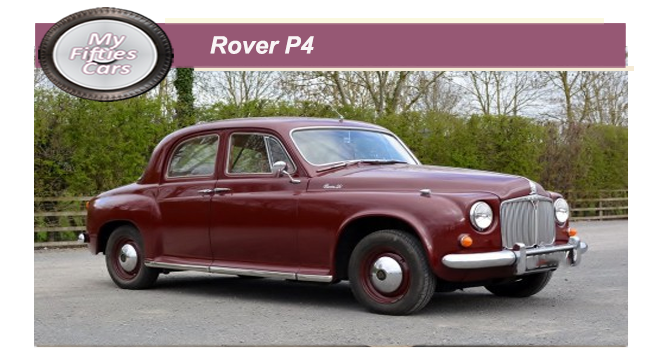
First of all, they had to pick themselves up from the ruins of their factory in Coventry which had been destroyed totally during a massive air raid in the city.
Secondly, to allow the new factory in Solihull, Birmingham to get into production as soon as possible, the company launched a utility vehicle known as the Land Rover, which proved to be a tremendous success and took up most of their production facilities.
R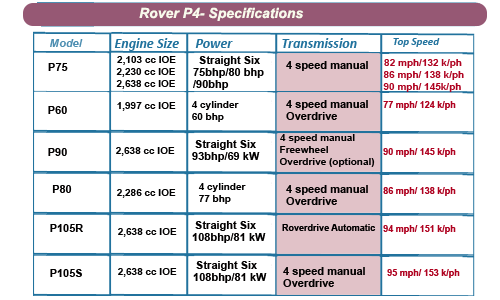 over were anxious to get back into traditional saloon car production, although it took the company almost four years until they could announce the launch of a new model ,the Rover P4, when it came it literally “broke the mold” when it came to the concept of how to introduce a four-door saloon design that would be both long-running and functional.
over were anxious to get back into traditional saloon car production, although it took the company almost four years until they could announce the launch of a new model ,the Rover P4, when it came it literally “broke the mold” when it came to the concept of how to introduce a four-door saloon design that would be both long-running and functional.
The Rover P4 75’s modern styling had more than a hint of new-fangled American streamlining about it. Indeed, the observers of design in the auto industry, the P4’s design outline border suspiciously strong resemblance to the contemporary Studebaker Champion, with rumours flying in the industry that a model had actually been broken down in the Solihull factory to be the subject of a very close study.
Compared with the P3, the chassis frame and the body were entirely new, though the same six-cylinder engine (complete with overhead inlet and side exhaust valves), four-speed transmission and freewheel were retained.
T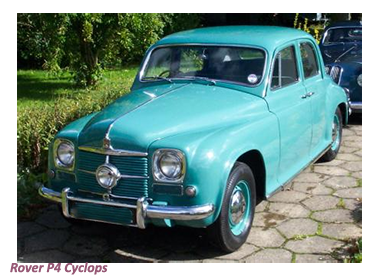 he body, provided by Pressed Steel, was a sober-looking four-door, initially with an extra "Cyclops" type of driving lamp in the centre of the grille, and a slightly truncated tail.
he body, provided by Pressed Steel, was a sober-looking four-door, initially with an extra "Cyclops" type of driving lamp in the centre of the grille, and a slightly truncated tail.
 The P4 was only sold as a saloon, though elements would be used in the company’s Marauder sports tourer.
The P4 was only sold as a saloon, though elements would be used in the company’s Marauder sports tourer.
Inside, there were leather seats, good carpets, lots of wood facings as well as a steering-column gear change carved in oak. The car's character, ambience, and manner of motoring were that of a "gentlemen's club", offering an ambience of a soft ride, a hushed interior, and no question of haste.
![]()
Without exception, all of the P4s shared the same 4-door saloon style and furnishings. In truth, it would take a real expert to separate one version of the P4 Series from the other with the only to identify one from the other was really by the badging.
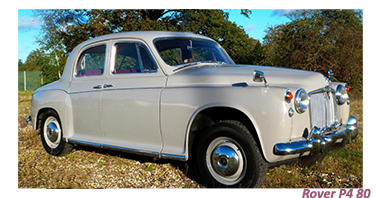 Gradually, but insistently, significant changes took place over the years. In1951 a full hydraulic braking system was adopted.
Gradually, but insistently, significant changes took place over the years. In1951 a full hydraulic braking system was adopted.
In March 1952 the original "Cyclops" style of front end was abandoned in favour of a conventional grille.
In the autumn of 1953 the twin-carb 90bhp 2638cc-engine 90 model joined the 75, and the gearbox at last gained synchromesh on second gear. From this point, the cars got a centre-floor gear change, with adjustable lever alignment.
In response to demand, in September of 1953 Rover announced the addition of a 60 version to the P4 Series.
 The Rover P4 60 was powered by a smaller and consequently the more economical four-cylinder engine, although the car’s overall appearance, trim and other technical features remained more or less exactly the same as the 75.
The Rover P4 60 was powered by a smaller and consequently the more economical four-cylinder engine, although the car’s overall appearance, trim and other technical features remained more or less exactly the same as the 75.
The changes were in line with the new Rover 90 whose launch was announced in conjunction with the 60.
With three models now running Rover made a change in the specifications fitting the cars with a central gear change lever that would allow the driver and two passengers to sit in the front of the car, three-abreast.
![]()
The new Rover P4 60 came fitted with a 2-litre engine that generated 60 bhp (45 kW) which had been previously fitted used in the early versions of the Land Rover though it now had modifications including a SU carburettor.
At the same time as the launch of the 60 Rover also released the 90 version, which once again was more or less identical in appearance, but had been fitted with a larger considerably more powerful 2.6 liter (160 cu in) six-cylinder engine, generating 90 bhp (67 kW) which allowed the car to reach speeds of up to 90 mph (145 km/h).
W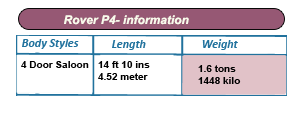 ith the launch of the P4 90 Rover confirmed their stated's stated intention to provide an answer for that wider range of motorists, each of whom could be looking for different degrees of performance as well as control of running costs.
ith the launch of the P4 90 Rover confirmed their stated's stated intention to provide an answer for that wider range of motorists, each of whom could be looking for different degrees of performance as well as control of running costs.
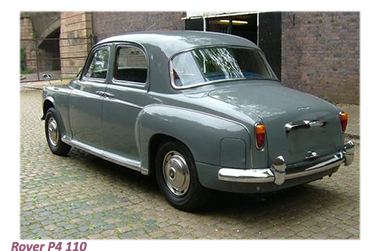 In October of 1954 on their stand at the Paris Motor Show Rover revealed what might have been regarded as necessary modifications to the P4 60, 75 and 90 designs - in particular a larger boot, wider rear window as well as flashing direction indicators.
In October of 1954 on their stand at the Paris Motor Show Rover revealed what might have been regarded as necessary modifications to the P4 60, 75 and 90 designs - in particular a larger boot, wider rear window as well as flashing direction indicators.
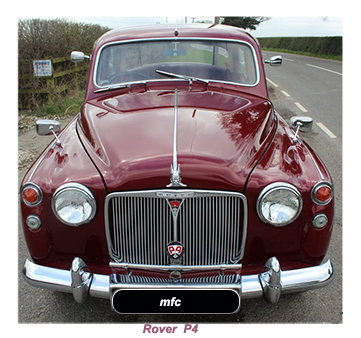 That same autumn, the Rover P4 75 model received an upgrade to an 80bhp 2230cc engine in place of the 2103cc unit, along with a slightly enlarged tail/boot and a wrap-around rear window.
That same autumn, the Rover P4 75 model received an upgrade to an 80bhp 2230cc engine in place of the 2103cc unit, along with a slightly enlarged tail/boot and a wrap-around rear window.
In the autumn of 1955, Laycock overdrive became available as an optional extra.
With overdrive fitted, the freewheel had to be abandoned. Finally, in autumn 1956, a front-end facelift included "sharper" front wings.
Still selling steadily, these cars were effectively replaced by the larger-engined, more powerful 100 and 110 models which followed in late 1959. Not that the 90 had been that slow: with overdrive, it was a relaxed 80mph cruiser
With production getting underway in late 1956, the 105 was yet another in the top-selling and much-loved series Rover P4 series.
![]()
The Rover P4 series 105 was the most powerful of any other cars in this series, as well as among the first to be fitted with automatic transmission as standard.
Encouraged by the initial pre-launch interest in the 105, Rover instituted a few changes to the model.
The two new derivatives launched, the105R and 105S, both of came with 2625cc 108bhp engines.
T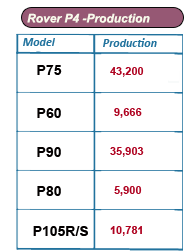 he 105R (with the R standing for Roverdrive) display being a unique automatic transmission, which included a torque converter, a manual clutch, two-speed-and-reverse gearbox as well as Laycock overdrive.
he 105R (with the R standing for Roverdrive) display being a unique automatic transmission, which included a torque converter, a manual clutch, two-speed-and-reverse gearbox as well as Laycock overdrive.
All these features and in particular the new and so-called game-changing transmission time turned out to be a bit of a disappointment for those who opted for it, as it made the car overweight and provided levels of performance best described as “ sluggish”.
Harnessed by its disappointing transmission, the 105R never really took off and was phased out that same summer.
M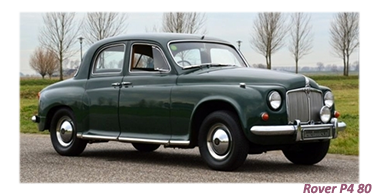 eanwhile, the 105S (with the S shock for Sporting) came fitted with a four-speed manual gearbox, complete with Laycock overdrive as standard.
eanwhile, the 105S (with the S shock for Sporting) came fitted with a four-speed manual gearbox, complete with Laycock overdrive as standard.
The S version of the 105 did a lot better than the R, so much so that in the summer of 1959, Rover retitled this version to launch as the 100, while at the same time discontinuing the 90 and 105.
 Around 33,000 original P4 75s were sold, and from it evolved the 60s, 75 Mk Hs, 80s, 90s, 95/110s, 100s and 105R/105Ss were added the production total for the P4 series was over 130,000 units.
Around 33,000 original P4 75s were sold, and from it evolved the 60s, 75 Mk Hs, 80s, 90s, 95/110s, 100s and 105R/105Ss were added the production total for the P4 series was over 130,000 units.
With all those different models, it might be assumed that there was considerable change during the life of the evolving P4. In fact that iconic design remained virtually unaltered to the end.
Take me back to the home page.


